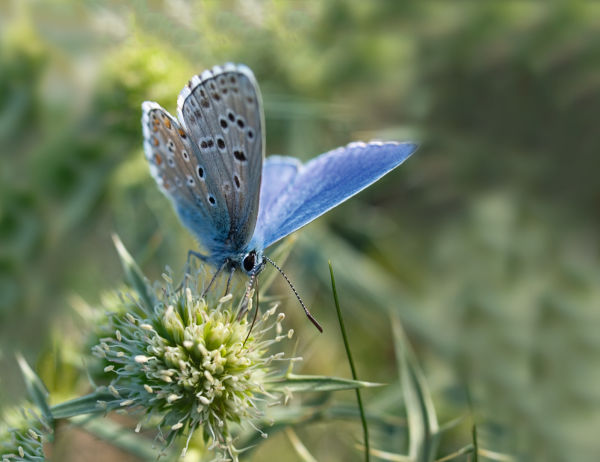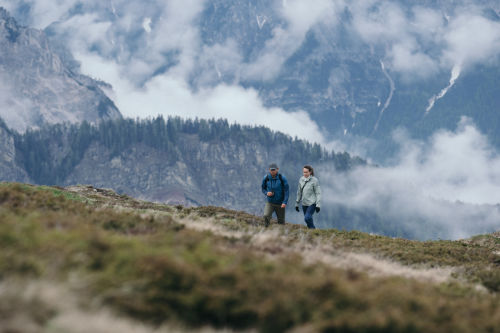What is the status quo of the habitats and diversity of species in South Tyrol, Italy? How do climate change and changes in land use affect biodiversity? Biodiversity Monitoring South Tyrol addresses these questions. The first results already give important insights.
Many know South Tyrol, the small region in the Italian Alps. Located in the northernmost part of Italy, bordering on Austria and Switzerland, it is a holiday destination for people from near and far. Alto Adige enchants with its incredible scenic beauty. But this very landscape is changing: Climate change and land use changes do not stop at the idyllic scenery. A team of researchers from Eurac Research, South Tyrol's leading scientific academy, is currently investigating how these changes affect biodiversity in the region. How are these investigations carried out and what findings has it brought to light so far?

Listen closely
Concerts at dawn
Quiet as a mouse, he stands there. A pair of binoculars around his neck, a telescope in front of him, a clipboard and pen in his hands. The ornithologist Matteo Anderle listens for 10 minutes in all directions to be able to identify the birds present. For this kind of work, it is better to be a morning person, as he visits the various survey points in the early hours of the morning. He works mainly with his hearing and identifies the birds by their chirping, singing, or calling. Time and again he uses binoculars or a telescope to identify the birds flying by or perching at a distance

Take a closer look
What exactly is being studied?
On a typical field day, when the ornithologist is just finishing observing birds at the various sites, his colleagues head off to other sites to study different groups of animals and plants. The ornithologist is part of a team of nine scientists who study the biodiversity of South Tyrol. These include
soil specialists,
a bat expert,
entomologists,
limnologists (experts on macroinvertebrates in freshwater) and
botanists.
The taxonomic groups studied were chosen because they are sensitive to external influences and are therefore good indicators of climate change and changes in land use.
Waves of the night
While bird surveys are primarily acoustic, the sounds of bats are not perceptible to the human ear. That is why Eurac Research's bat expert mounts ultrasonic recording devices. These so-called "bat loggers" record the sounds of the bats and reproduce them as waves on the computer. In this way, the expert can identify the bat species and determine their frequency.

Catch me if you can
Hunting for insects
For the grasshopper and butterfly surveys, experienced entomologists go into the field with a fine-meshed net to catch individuals of the studied group. For the grasshopper survey, the expert sweep-nets the low vegetation along a marked straight line. The expert for butterflies, on the other hand, walks along a defined line and catches spotted butterflies directly, for which he often has to make a spontaneous sprint to get a spotted butterfly into the net. This is no easy task because the butterflies are faster than one might think. Once the animals are in the net, they are identified by the respective expert and then released back into the wild.
Digging deep
Finally, the team's soil experts remove blocks of soil with the help of a square mould. These soil blocks are taken back to the laboratory to extract the soil organisms and determine the soil type. A specialist for surface-active invertebrates also uses pitfall traps to collect insects, spiders and other creepy crawlies that live on the soil surface.
Botanical surveys
Like animal and insect surveys, botanical surveys are detailed work. In a 10 x 10 m square, the botanist determines all plant species present, from the tree to the smallest blade of grass. As part of the botanical survey, he also takes samples of bryophytes and lichen.
All these surveys are repeated every five years at the exact same site. This allows long-term trends to be identified and suitable management and conservation measures to be developed.

Biodiversity monitoring to record and observe nature inventory in the long term
First results on the avifauna and habitats of South Tyrol
The first survey points were examined in spring and summer 2019 and 2020. In autumn 2020, two survey seasons were completed. The surveyed points will be surveyed again after every five years. So far, the status quo of the different habitats surveyed can be described. Meadows and pastures, crop fields and permanent crops (vineyards, apple orchards), settlement areas, wetlands, forests, and alpine habitats are studied. These are the most representative habitats for South Tyrol.

About
EURAC Research
EURAC research addresses the greatest challenges facing us in the future: people need: health, energy, well-functioning political and social systems and an intact environment. These are complex questions. The association is seeking the answers in the interaction between many different disciplines. In so doing, their research work embraces three major themes:
regions fit for living in,
diversity as a life-enhancing feature,
a healthy society.
All pictures ©EuracResearch















